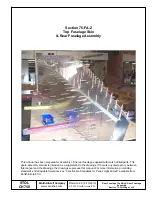
737 MAX Flight Crew Operations Manual
Flight Instruments, Displays -
MAX Display System – Primary
Flight Display
10.30.2
MN-FLT-OH-201
Pitch attitude is displayed by an airplane symbol against a pitch scale. The pitch
scale is in 2.5 degree increments.
A pointer indicates bank angle in increments of 10, 20, and 30 degrees. Single
marks indicate 45 and 60 degrees of bank. A small rectangle under the bank angle
pointer indicates slip and skid conditions. Bank angle is also represented by the
attitude of the airplane symbol against the horizon line and pitch scale.
1B402 - 1B786, 1B807 - 1J585, 1J592 - 1J594
A pitch limit indication is displayed at all times when the flaps are not up. In some
airplanes, when flaps are up and airspeed approaches stick shaker activation for
existing flight conditions.
Angle of Attack
1B401, 1B402, 1B801 - 1B824
(as installed)
The Angle of Attack (AOA) indicator displays aircraft body angle of attack, stick
shaker angle of attack, and the appropriate range of approach angle of attack. The
indicator is located in the upper-right corner of the PFD, above the ADI.
If the AOA signal is determined to have failed or is invalid when ground speed is
greater than 80 knots, the AOA indicator will be blanked and replaced with a fail
flag.
During normal operation, the approach reference band moves with flap handle
position. When the flap handle is in a landing flap detent, the band will depict the
appropriate range of AOA for a Vref(xx)+5 approach, where Vref(xx) is for the
corresponding flap detent position. If the flaps are driven in alternate mode, the
band moves depending on actual flap position. If flap position is determined to be
invalid, the band is blanked.
If an approach is flown faster than Vref(xx)+5, AOA is lower than normal and
could potentially be below the band. If a slower approach is flown, AOA is higher
than normal and could be above the band.
Steering Indications
The flight director is displayed when the related flight director switch is on. Pitch
and roll commands are displayed independently.
The Flight Path Vector (FPV) symbol represents airplane flight path angle
vertically and drift angle laterally. The flight path vector is displayed on the PFD
when the EFIS control panel FPV switch is selected on. The FPV shows the Flight
Path Angle (FPA) above or below the horizon line and drift angle left or right of
the pitch scale's center. The FPA uses inertial and barometric altitude inputs. The
vertical FPA is unreliable with unreliable primary altitude displays.
March 1, 2021
















































